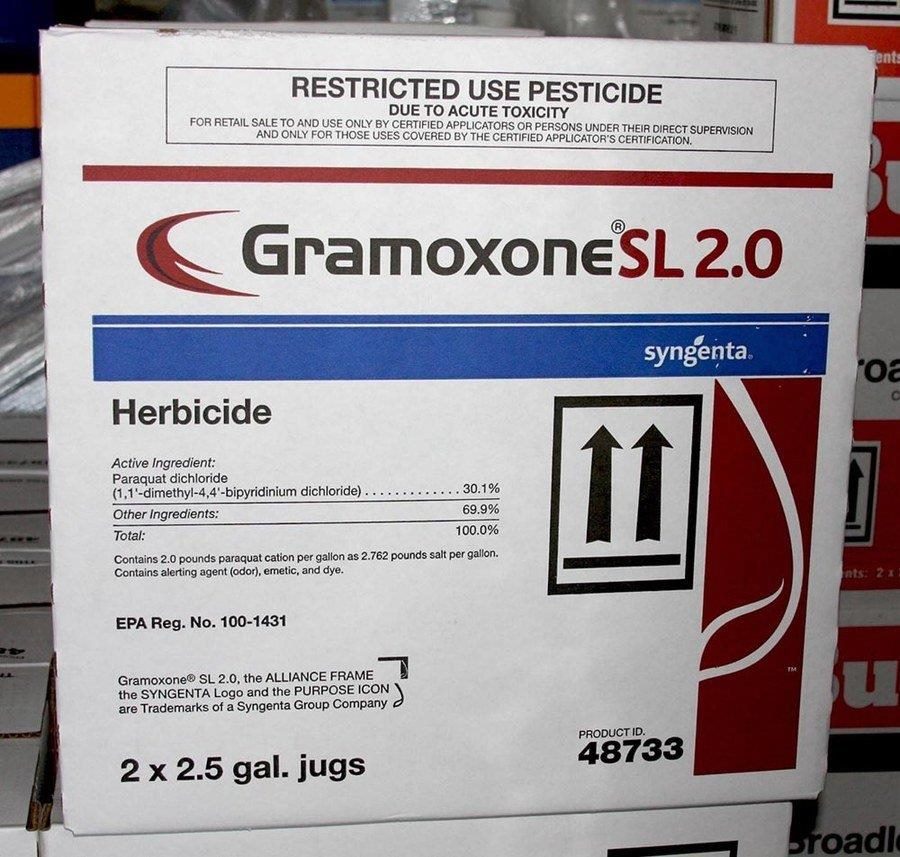What are the effects and symptoms of paraquat poisoning? This depends on the amount, route, and duration of exposure along with the person's current health status. Acute localized dermal exposure causes the reddening, blistering, and wearing away of the skin. Prolonged chronic dermal exposure can result in systemic absorption with cuts and abraded skin increasing the rate of absorption. The prolonged inhalation of spray droplets has caused localized nose bleeds in some individuals. When paraquat is ingested, it damages the lining of the mouth, stomach, and intestines upon contact. It then spreads throughout the body damaging organs, but primarily the lungs, liver, and kidneys.
Some of the symptoms of a paraquat poisoning can occur within a few hours to days afterward include confusion, fast heart rate, muscle weakness, pulmonary edema (swelling caused by fluids in body tissues), seizures, coma, and respiratory failure. Immediate symptoms associated with ingesting large amounts of paraquat include pain and swelling of the mouth and throat, gastrointestinal symptoms (nausea, vomiting, abdominal pain, and diarrhea) which can result in dehydration, electrolyte abnormalities, and low blood pressure.

A box of Gramoxone SL 2.0, which contains paraquat. Photo: Penn State Pesticide Education.
Always Wear PPE
Due to these significant exposure concerns, always wear the personal protective equipment (PPE) specified on the label. The PPE listed is based on the product's toxicity, formulation, volatility, and exposure risk. Remember, PPE protects you and reduces your risk to exposure when using pesticides.
When using paraquat, the required PPE depends on whether you are applying or mixing and loading. The following is the PPE that must be worn when applying or handling paraquat (other than mixing and loading):
- Long-sleeve shirt and long pants
- Shoes plus socks
- Protective eyewear
- Chemical-resistant gloves made of: barrier laminate, butyl rubber ≥ 14 mils, nitrile rubber ≥ 14 mils, neoprene rubber ≥ 14 mils, natural rubber ≥ 14 mils, polyethylene, polyvinyl chloride (PVC) ≥ 14 mils, or Viton ® ≥ 14 mils
- NIOSH-approved particulate respirator with any N, R, or P filter, NIOSH approval number prefix TC-84A (particulate filtering respirator), or a NIOSH-approved powered air-purifying respirator (PAPR) with a high efficiency (HE) filter with NIOSH approval number prefix TC-21
Individuals that are mixing and loading are required to wear the PPE listed above plus a chemical-resistant apron and a face shield instead of protective eyewear.
Risk Mitigation Requirements
Over the years concerns have been raised relating to paraquat exposure. Approximately 1 to 2 deaths per year have occurred from the accidental ingestion of paraquat. These deaths have been primarily due to paraquat being illegally transferred and stored in beverage containers that were then mistakenly consumed. In addition, many severe injuries have resulted from contact with the skin or eyes of individuals who mix, load, and apply paraquat.
To minimize these exposures to paraquat, the EPA implemented risk mitigation requirements in 2016 that included changes to product labels, the distribution of supplemental warning materials, further restricting its use so it can only be used by a certified applicator, requiring certified applicators to take specialized training every three years, and requiring closed-system packaging on all non-bulk containers.
Training Requirements
All certified applicators using paraquat are now required to complete a paraquat-specific training program approved by the EPA. This training must be successfully completed before using any paraquat product. In addition, all certified applicators who handle paraquat are required to take the course every three years. Upon successful completion, a certificate will be issued that must be maintained by the applicator to document the training.
The manufacturers of paraquat have developed an EPA-approved training module, which is offered online in both English and Spanish. This training is offered through a third party, the National Pesticide Safety Education Center (NPSEC). Provisions have been made to offer the training as an in-person format. However, these in-person meetings must be administered by an individual that is registered with NPSEC as a trainer.
Note: Products may still be in the marketplace with the old labels that do not require the training. It is important that you read the label in order to know if you have a product with the old or new label. The training is only required for those products with the new label that references the training. You must follow the label directions that are on the container being used.
Protect yourself and others by never putting paraquat or other pesticides in food or beverage containers, wearing the required PPE, and always reading and following label directions.
Source : psu.edu